Optimizing LED Lamps for Industrial Use Explained
Optimizing LED Lamps for Industrial Use Explained
Blog Article
Whether you're outfitting a warehouse, a logistics hub, or a production floor, industrial LED solutions provide unmatched performance, durability, and savings.
This article explores key advantages of buying LED lamps in bulk, the role of high bay LED fixtures in industrial spaces, and importadora de lampadas what to look for in an experienced LED lighting importer.
Let’s start by looking at the reasons why sourcing LED lighting wholesale is not only cost-effective—but also the smarter long-term choice for industrial facilities.
Why Wholesale LED Makes Sense for Industrial Buyers
Buying LED lamps at wholesale prices offers multiple advantages for businesses managing large-scale lighting needs.
Working with an LED importer or distributor helps secure better warranties, product availability, and technical support.
Whether you need fixtures for ceilings over 30 feet high or task lighting for assembly zones, buying in volume allows better system-wide integration.

Why Industrial Facilities Should Upgrade to LED Lighting
LEDs consume up to 75% less energy than traditional metal halide or fluorescent systems, significantly cutting monthly utility bills.
High-quality industrial LEDs deliver brighter, more uniform illumination, reducing shadows and minimizing workplace accidents.
Industrial LEDs also require less maintenance, thanks to their long lifespan—often exceeding 50,000 hours.
Why Choose High Bay LED Lighting for Warehouses
High bay LED fixtures are designed for spaces with high ceilings—typically 20 to 45 feet—common in warehouses, distribution centers, and manufacturing plants.
Compared to legacy high-intensity discharge (HID) fixtures, high bay LEDs offer better energy efficiency, instant-on capability (no warm-up time), and superior color rendering.
Advanced models, like the High Bay LED EVO, combine cutting-edge optics, durable construction, and smart features such as dimming or sensor integration.
Key Features of High Bay LED EVO Fixtures
Engineered for maximum performance, these fixtures combine high lumen output with exceptional energy efficiency, making them ideal for large spaces with demanding lighting needs.
This adaptability allows facility managers to fine-tune lighting layouts and reduce unnecessary energy consumption.
Companies seeking to modernize their lighting systems should consider the EVO series as a top-tier option offering durability, efficiency, and cutting-edge features.

Choosing a Reliable LED Lighting Supplier
Working with a trusted LED importer or supplier ensures you receive high-quality products, competitive pricing, and reliable service.
Look for suppliers that maintain robust inventories and have strong relationships with manufacturers.
Finally, assess their technical support capabilities.
Why Investing in Quality LED Lighting Pays Off
When combined with top-tier products like High Bay LED EVO, businesses achieve not just cost efficiency but also operational excellence.
It’s not just about purchasing light fixtures—it’s about building a long-term partnership that helps your facility stay competitive and sustainable.
By acting now, you position your business at the forefront of innovation, reaping financial and environmental benefits for years to come.
Common Questions About LED Lighting for Warehouses
Why should I purchase LEDs in bulk?
Buying LEDs wholesale lowers unit costs, simplifies logistics, ensures product consistency, and often provides better warranties.
What is a high bay LED light?
They provide powerful, even illumination across wide areas, improving visibility and safety.
What makes the High Bay LED EVO different?
The High Bay LED EVO offers advanced thermal management, flexible mounting, smart lighting integration, and superior energy efficiency.
How do I choose a reliable LED supplier or importer?
A good importer ensures product quality, compliance, fast delivery, and long-term partnership.
Are LEDs worth the investment?
Industrial LED upgrades can reduce energy costs by up to 75% and maintenance costs by up to 50%.
Report this page